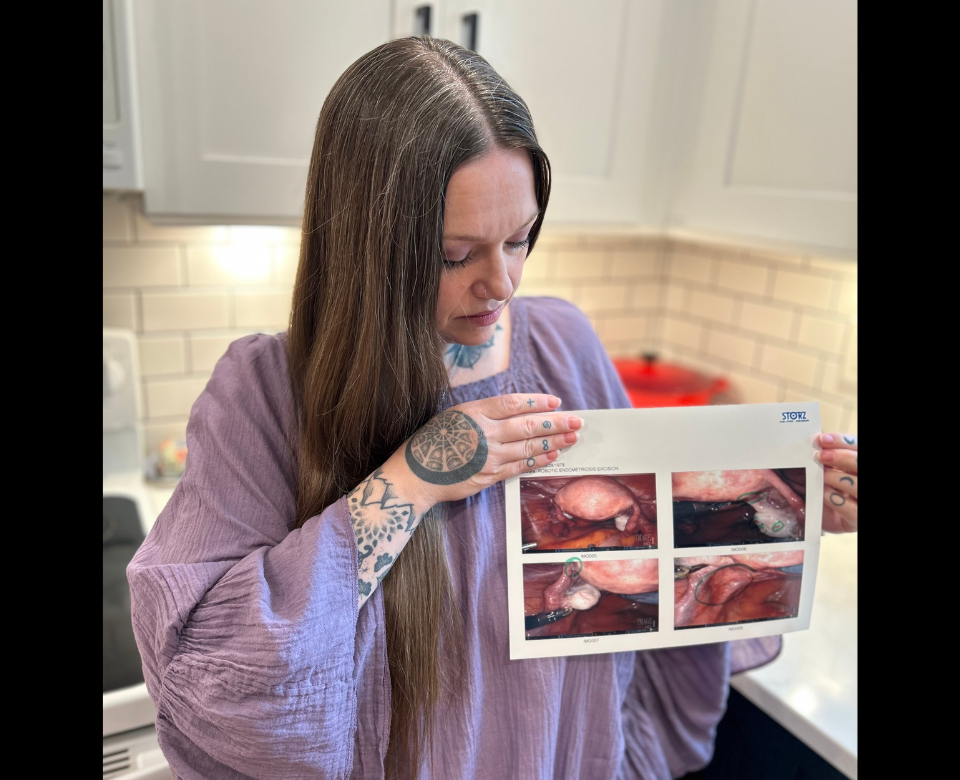Former Longmont resident Amanda Moon has endured a life of pain since the age of 12. Like her, many women suffer during their periods and either endure it or seek out answers, only to come up short. This year, Longmont residents will have a chance to learn more about the disease that causes period pain and have the opportunity to help others too.
Moon was 12 years old when she started her period and began experiencing debilitating pain. Other women in her family suffered in the same way and the consensus was that it was something to push through each month.
At age 19, Moon went in for laparoscopic surgery. This was when she learned that one of her ovaries was covered in lesions and that she had endometriosis.
The endometrium is the lining of the uterus. Similar cells can form outside of a woman’s uterus but within in abdomen which is called endometriosis.
Women diagnosed with endometriosis can experience intense pelvic pain and sometimes infertility. In addition to painful periods, women can experience painful intercourse, painful bowel movements, daily pain in the pelvis, abdomen or chest, bloating, constipation or diarrhea.
Most women experience these things primarily with their cycle, however, the pain can exist daily in some cases.
Moon was fortunate to be diagnosed at an early age and within such a short time of starting her period.
According to Dr. Brian Nelson, a gynecologic surgeon at UCHealth Longs Peak Hospital, it is hard to know how many women might actually be afflicted with the disease because many are misdiagnosed or not diagnosed at all. However, according to recent studies, 10% of women are expected to have the disease, Nelson said.
“Women will also see an average of seven to ten practitioners before they are diagnosed and it usually takes eight to ten years for the average patient to get an accurate diagnosis,” Nelson said.
While some practitioners may suspect that endometriosis is the reason for these symptoms, the only way to confirm the diagnosis is through surgery.
When Moon was first diagnosed, the only treatment available was to burn off the lesions. This left scar tissue and didn’t actually solve the problem. Moon said she didn’t feel any different after the surgery as the pain continued.
Moon spent most of her 20s and 30s pregnant or nursing so she didn’t have very many periods, she said. After her sixth child, she was done having babies.
Her periods returned, as did the pain.
“When my cycle came back after the sixth baby, the pain was on a whole other level. It wasn’t just while I was bleeding, the pain was lasting longer and longer throughout my cycle. It got to a point where I was in agonizing pain every single day. It just took up so much of my life,” Moon said.
The pain became like another person in Moon’s life to accommodate. With a family of six children and a husband, Moon was missing out on valuable time with her loved ones, especially on days she was unable to get out of bed, she said.
She sought out Nelson’s help despite no longer trusting the medical community.
“I felt surgery was my last option,” Moon said.
Nelson is one of the few gynecologic surgeons in the country. These specialists use a laparoscopic surgery to precisely cut away the endometriosis. While this procedure is not a cure, Nelson said, it can help women feel relief from the immense pain they were feeling before. Some are even able to manage the pain with alternative pain management techniques, such as acupuncture or physical therapy, and ibuprofen, he said.
Michele Forsberg is the owner and a physical therapist at Align PT in Longmont. She specializes in physical therapy in the pelvic region. She also works with endometriosis patients before and after their surgeries.
However, the topic of endometriosis is much more personal to Forsberg. Her daughter was recently diagnosed with the disease but suffered for years before Forsberg’s advocacy paid off when they found a doctor who would listen.
Because of her journey, Forsberg feels strongly that endometriosis education should be more common among women and health care providers.
Forsberg is organizing a screening of “Below the Belt” — a documentary that follows four women’s struggle with the disease — on March 8 at the Longmont Museum. A reception will begin at 5:30 p.m. and the film will start at 6 p.m. Registration is required.
A panel discussion will follow the screening and will include Nelson; Kyrie Carlson, UCHealth nurse practitioner; Melina Sharkey, UCHealth physician assistant; Margo Gasta, a functional medicine dietitian; Dr. Kelly Parcel, a naturopath from NatureMed; and Forsberg.
While the night is focused on educating the Longmont community about endometriosis, Forsberg has another plan. All the proceeds from the event will go to Endo Collective. The organization will provide educational toolkits to school nurses, pediatricians and primary care providers across the country in an effort to educate more girls and women about the disease.
“There’s so much misinformation about endometriosis and there’s a lot of medical gaslighting with patients because they’re told it is in their head, they’re told that they can’t possibly have endometriosis by physicians that don’t really know better,” Forsberg said. “This is to educate the public and to hold space for women that have gone through this kind of struggle.”
Both Forsberg and Moon hope to empower women to advocate for themselves until they find a physician who will listen to their concerns.
“I have spoken to so many women over the years who have lived in pain and it has become so normalized to them — and normalized throughout society really — periods are just painful … I think that just an awareness, an acknowledgement, of women’s pain … women deserve to have their pain recognized,” Moon said.



